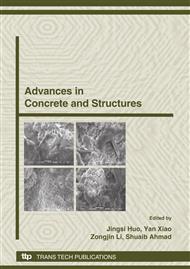p.621
p.627
p.633
p.639
p.645
p.651
p.659
p.667
p.677
Finite Element Analysis of Small Span Reinforced Concrete Trough Railway Bridge
Abstract:
The static behavior of a reinforced concrete trough railway bridge is analyzed by finite element method. The influences of load distribution fashion, supporting width of the bearings and the additional support beneath the girder are investigated; and the spatial effect of the stress distribution is studied as well. To confirm the analysis accuracy, the results are calibrated with the field load test results. It is found that the influence of load distribution fashion is minor and negligible, while those of supporting width and additional support are not negligible; and the spatial effect is significant.
Info:
Periodical:
Pages:
645-650
Citation:
Online since:
October 2008
Authors:
Permissions:
Share:
Citation:


